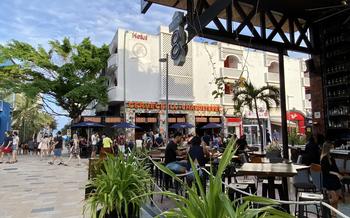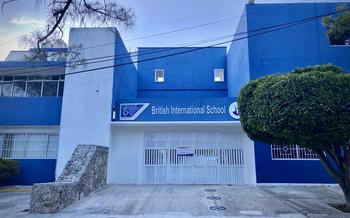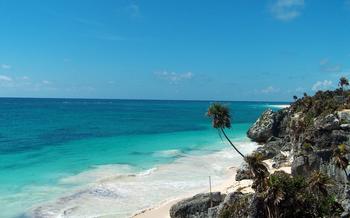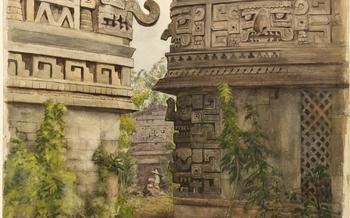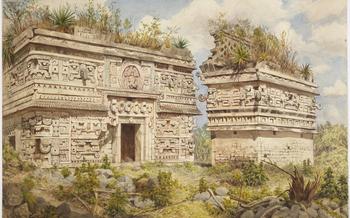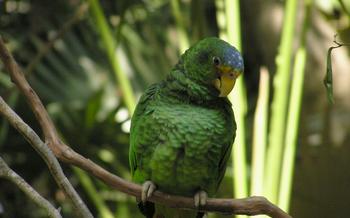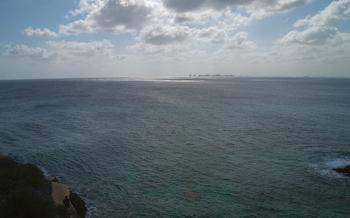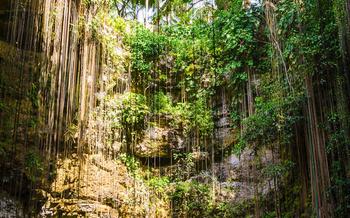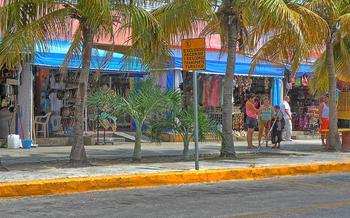
Punta Laguna Nature Reserve
- Punta Laguna Nature Reserve: A Haven for Nature Lovers
- Transportation to Punta Laguna
- Guided Tours or Self-Exploration: Choosing Your Adventure
- What to Expect During Your Visit:
- The Importance of Conservation
- Community Involvement in Conservation
- Supporting Ethical Tourism
- Exploring the Mayan Culture
- Facilities and Amenities at the Reserve
- Wildlife Conservation Projects
- Tips for Birdwatching Enthusiasts
- Hiking Trails for All Levels
- Cultural Workshops and Demonstrations
- Insider Tip: Plan Your Visit During the Dry Season
Punta Laguna Nature Reserve: A Haven for Nature Lovers
Punta Laguna Nature Reserve, located in the heart of the Yucatan Peninsula, Mexico, is a stunning oasis of biodiversity and a sanctuary for nature enthusiasts. This lush reserve encompasses over 1,000 acres of pristine jungle, cenotes, and wetlands, providing a habitat for a diverse array of flora and fauna. Visitors to Punta Laguna can immerse themselves in the wonders of the natural world, explore ancient Mayan ruins, and contribute to conservation efforts that protect this unique ecosystem.
Biodiversity: The reserve boasts an incredible variety of plant and animal life. Over 200 species of birds, including colorful toucans, parrots, and woodpeckers, flutter among the trees. Howler monkeys, spider monkeys, and white-tailed deer roam the jungle, while turtles, crocodiles, and iguanas bask in the sun along the shores of the cenotes.
Conservation Efforts: Punta Laguna is dedicated to preserving its rich biodiversity through various conservation initiatives. The reserve works with local communities to protect the habitat, reduce deforestation, and promote sustainable practices. Research and monitoring programs are conducted to track wildlife populations and identify threats to the ecosystem.
Community Involvement: The local Mayan community plays a vital role in the conservation and management of the reserve. They have a deep connection to the land and are committed to protecting their ancestral home. The community benefits from the reserve through sustainable tourism initiatives, which provide economic opportunities and support cultural preservation.
Ethical Tourism: Punta Laguna Nature Reserve emphasizes ethical tourism practices that minimize environmental impact and support the local economy. Visitors are encouraged to choose responsible tour operators that adhere to sustainable guidelines and respect the rights of the local community.
Transportation to Punta Laguna
The Punta Laguna Nature Reserve is located approximately 75 kilometers southwest of Cancun, in the state of Quintana Roo, Mexico. While the reserve is relatively easy to reach, visitors have several options for transportation depending on their budget and preferences.
For those without a car, public transportation is a viable option. Buses depart from Cancun's main bus station and take about two hours to reach the reserve. The fare is around $15 USD. Once in the town of Punta Laguna, visitors can take a short taxi ride or walk to the reserve entrance.
Renting a car is another option for those who want more flexibility and independence. Several car rental companies operate in Cancun, and prices start at around $40 USD per day. The drive to Punta Laguna takes about an hour and a half, and the reserve has ample parking space for visitors.
No matter the chosen transportation method, visitors should plan enough time for travel as the journey can take longer than expected, especially during peak tourist season.
Guided Tours or Self-Exploration: Choosing Your Adventure
Whether you prefer the convenience of a guided tour or the freedom of self-exploration, Punta Laguna Nature Reserve offers both options to enhance your visit.
Benefits of a Guided Tour:
Embarking on a guided tour at Punta Laguna Nature Reserve comes with several advantages. Experienced local guides lead these tours, sharing their wealth of knowledge about the reserve's ecosystem, wildlife, and Mayan culture. They will point out specific species, explain their significance, and answer any questions you may have. Guided tours also ensure that you don't miss any of the reserve's highlights, as they follow a carefully planned route.
Cost of a Guided Tour:
Guided tours typically range from $20 to $40 per person, depending on the group size and the length of the tour. Some tours include additional activities like canoeing or birdwatching, which may come at an extra cost.
Languages Available:
Guided tours are usually conducted in English and Spanish, but other languages may be available upon request. It's best to inquire about the available languages when booking your tour.
Self-Guided Exploration Options:
For those who prefer to explore at their own pace, self-guided tours are also an option at Punta Laguna Nature Reserve. You can rent a bike or kayak and follow the designated trails and waterways. Maps and signage are provided throughout the reserve to help you navigate your way.
What to Expect During Your Visit:
Punta Laguna Nature Reserve offers a diverse range of experiences for visitors, catering to nature lovers, wildlife enthusiasts, and adventure seekers alike.
Wildlife Spotting:
The reserve is home to a variety of wildlife species, including monkeys, spider monkeys, howler monkeys, and various species of birds. Keep an eye out for these fascinating creatures as you explore the reserve's trails and waterways.
Birdwatching Opportunities:
Punta Laguna is a paradise for birdwatchers, with over 200 species of birds recorded in the area. The reserve's diverse habitats, including forests, wetlands, and lagoons, provide ideal conditions for birdwatching. Look for species such as toucans, parrots, and the endangered jabiru stork.
Hiking Trails:
Several well-maintained hiking trails wind through the reserve, offering visitors the chance to explore the diverse ecosystems and enjoy the natural beauty of the area. Trails range from easy to challenging, catering to hikers of all levels.
Cultural Experiences:
The Punta Laguna Nature Reserve is situated within the territory of the Mayan community, and visitors have the opportunity to learn about and experience Mayan culture firsthand. Participate in cultural workshops, demonstrations, and guided tours led by local Mayan guides.
The Importance of Conservation
The Punta Laguna Nature Reserve plays a crucial role in preserving the region's rich biodiversity and supporting conservation efforts. The reserve's conservation initiatives focus on protecting the native flora and fauna, particularly the spider monkeys and their habitat. Conservationists work tirelessly to monitor and study the monkey population, ensuring their well-being and survival.
One of the significant threats to the reserve's ecosystem is deforestation, driven by agricultural expansion and human encroachment. To combat this, reforestation projects are implemented to restore degraded areas and create new forest corridors. These efforts not only benefit the wildlife but also contribute to carbon sequestration and climate change mitigation.
Tourism plays a vital role in supporting conservation efforts at Punta Laguna. The revenue generated from entrance fees and guided tours directly contributes to the reserve's conservation initiatives. Additionally, tourism raises awareness about the importance of preserving natural habitats and the unique wildlife found in the reserve.
Sustainable practices are emphasized to minimize the environmental impact of tourism activities. Visitors are encouraged to respect the natural surroundings, dispose of waste responsibly, and avoid disturbing wildlife. By adopting responsible tourism practices, visitors can contribute to the long-term sustainability of the reserve and its conservation efforts.
Community Involvement in Conservation
The local Mayan community plays a vital role in the conservation efforts of Punta Laguna Nature Reserve. Their ancestral knowledge and deep connection to the land have been instrumental in preserving the reserve's ecosystem and cultural heritage.
The Mayan community has been involved in conservation initiatives since the reserve's inception, working closely with scientists and researchers to protect the flora and fauna. They actively participate in reforestation projects, wildlife monitoring, and sustainable tourism practices.
Cultural preservation is another important aspect of the community's involvement. They share their traditions, stories, and handicrafts with visitors, fostering a deeper understanding and appreciation of Mayan culture. This cultural exchange not only enriches the visitor experience but also helps preserve the community's unique identity.
Economic benefits from tourism also play a crucial role in the community's involvement in conservation. The reserve provides employment opportunities for local people as guides, artisans, and cooks, creating a sustainable source of income that incentivizes conservation efforts.
Community-led conservation initiatives, such as the establishment of a community-run butterfly farm and a sustainable beekeeping program, further demonstrate the community's dedication to protecting their environment and generating economic benefits. These initiatives not only contribute to the conservation of local wildlife but also empower the community to take an active role in shaping their future.
Supporting Ethical Tourism
Ethical tourism is crucial for preserving the delicate ecosystem of Punta Laguna Nature Reserve and supporting the local Mayan community. When visiting the reserve, consider the following tips to ensure your trip is both enjoyable and sustainable:
Choose responsible tour operators: Research tour operators that prioritize ethical practices, support conservation efforts, and respect the rights of the local community. Look for operators that are certified by reputable organizations such as the Rainforest Alliance or the Tour Operators Initiative for Sustainable Tourism.
Respect the environment: Minimize your impact on the environment by following designated trails, avoiding disturbing wildlife, and refraining from littering. Dispose of waste properly in designated bins and avoid using single-use plastics.
Practice cultural sensitivity: Be respectful of local customs and traditions. Ask permission before taking photos of people, and avoid intrusive behavior. Learn a few basic Spanish phrases to communicate with local guides and community members.
Minimize your impact: Reduce your carbon footprint by opting for transportation options that minimize emissions, such as taking public transportation or renting a hybrid or electric car. Consider staying in eco-friendly accommodations that support conservation initiatives.
Exploring the Mayan Culture
The Punta Laguna Nature Reserve is nestled within a region steeped in Mayan history and culture. Visitors can immerse themselves in the rich heritage of the Maya by exploring the nearby Mayan ruins, learning about their traditions and customs, and supporting local artisans. The reserve's proximity to ancient cities like Chichen Itza and Tulum allows for easy day trips to witness the grandeur of these iconic sites. Additionally, the reserve itself holds historical significance, having been a place of refuge for the Maya during the Caste War of the 19th century. By visiting Punta Laguna, travelers can gain a deeper understanding of the Maya's enduring legacy and contribute to the preservation of their cultural heritage.
Facilities and Amenities at the Reserve
Punta Laguna Nature Reserve provides several facilities and amenities to enhance visitors' experiences and ensure their comfort during their exploration. A well-equipped visitor center serves as the starting point for your adventure, where you can gather information about the reserve, its history, and conservation efforts. The center features informative exhibits, maps, and brochures to help you plan your visit.
Restrooms are conveniently located throughout the reserve to cater to visitors' needs. Designated picnic areas with tables and seating allow you to enjoy a packed lunch surrounded by the tranquil beauty of the natural surroundings. For those with accessibility concerns, the reserve is wheelchair-friendly, featuring accessible trails and facilities to ensure an inclusive experience for all visitors.
Wildlife Conservation Projects
The Punta Laguna Nature Reserve is committed to wildlife conservation through various projects and initiatives. These projects aim to protect and restore the reserve's diverse ecosystem and its endangered species.
-
Animal rehabilitation: The reserve operates a wildlife rehabilitation center that provides care and treatment to injured or orphaned animals. Visitors can learn about the center's work and witness the release of rehabilitated animals back into the wild.
-
Reforestation efforts: The reserve actively engages in reforestation projects to restore degraded areas and increase the forest cover. Visitors can participate in tree-planting activities and contribute to the conservation of the reserve's habitat.
-
Wildlife research: The reserve collaborates with scientists and researchers to conduct wildlife research and monitoring programs. This research helps to understand the behavior, ecology, and conservation status of the reserve's species.
-
Volunteer opportunities: Visitors interested in getting involved in conservation can volunteer at the reserve. Volunteer opportunities include assisting with animal rehabilitation, tree planting, wildlife monitoring, and educational programs.
Tips for Birdwatching Enthusiasts
Punta Laguna is a birdwatcher's paradise, with over 250 species of birds recorded in the reserve. The best time for birdwatching is during the dry season (November to May), when the weather is clear, and the birds are most active. Some of the species you can expect to see include toucans, parrots, woodpeckers, and various migratory birds.
To enhance your birdwatching experience, bring a pair of binoculars and a field guide to help you identify the different species. You can also download a birdwatching app on your smartphone to assist you. Remember to be patient and quiet, as sudden movements or loud noises can scare away the birds.
If you're a serious birdwatcher, consider hiring a local guide who can take you to the best spots for birdwatching and help you identify the different species. Guided tours typically last for several hours and include transportation, binoculars, and a field guide.
To attract birds to your location, you can set up a bird feeder or place a bowl of water near your observation point. You can also try imitating bird calls to attract their attention.
Remember to respect the birds and their environment. Avoid disturbing their nests or eggs, and always dispose of your trash properly. By following these tips, you can have a memorable and rewarding birdwatching experience at Punta Laguna Nature Reserve.
Hiking Trails for All Levels
The Punta Laguna Nature Reserve offers a diverse range of hiking trails suitable for adventurers of all experience levels. Whether you're a seasoned hiker looking for a challenging trek or a beginner seeking a leisurely stroll, you'll find a trail that meets your needs.
The reserve's trail system is well-maintained and clearly marked, ensuring a safe and enjoyable hiking experience. Trail maps and signage are provided to guide you along the paths, and knowledgeable guides are available to provide additional information and assistance.
For those seeking a leisurely walk, the reserve offers flat, easy-to-navigate trails that wind through the lush forest, allowing you to immerse yourself in the tranquil beauty of the surroundings. These trails are ideal for families with young children or individuals who prefer a more relaxed pace.
More experienced hikers can embark on challenging trails that lead to stunning viewpoints, hidden waterfalls, and secluded swimming spots. These trails often involve steeper inclines and rougher terrain, providing a more strenuous workout and rewarding experience.
Remember to wear comfortable shoes, bring plenty of water, and be prepared for varying weather conditions. Hiking poles can also be helpful for added support and stability, especially on uneven terrain.
Cultural Workshops and Demonstrations
Immerse yourself in the rich Mayan culture through hands-on workshops and captivating demonstrations at the Punta Laguna Nature Reserve. Learn the art of traditional Mayan cooking, where you'll create delicious dishes using fresh, local ingredients and ancient techniques. Discover the secrets of weaving, pottery, and woodcarving, guided by skilled Mayan artisans who share their knowledge and passion for their craft. Participate in cultural performances that showcase the vibrant music, dance, and storytelling traditions of the Mayan people. These immersive experiences provide a unique opportunity to connect with the local community, appreciate their cultural heritage, and gain a deeper understanding of their way of life. Don't miss the chance to take home handmade souvenirs that you create during these workshops, serving as lasting mementos of your time in Punta Laguna.
Insider Tip: Plan Your Visit During the Dry Season
For an optimal experience, plan your visit to the Punta Laguna Nature Reserve during the dry season, which typically runs from November to April. During this time, you'll encounter more favorable weather conditions, with less humidity and fewer chances of rain. The reduced water levels also make it easier to spot wildlife, as animals congregate around the remaining water sources. As an added bonus, the dry season often coincides with the peak migration period for birds, providing you with the opportunity to witness a diverse array of bird species.
